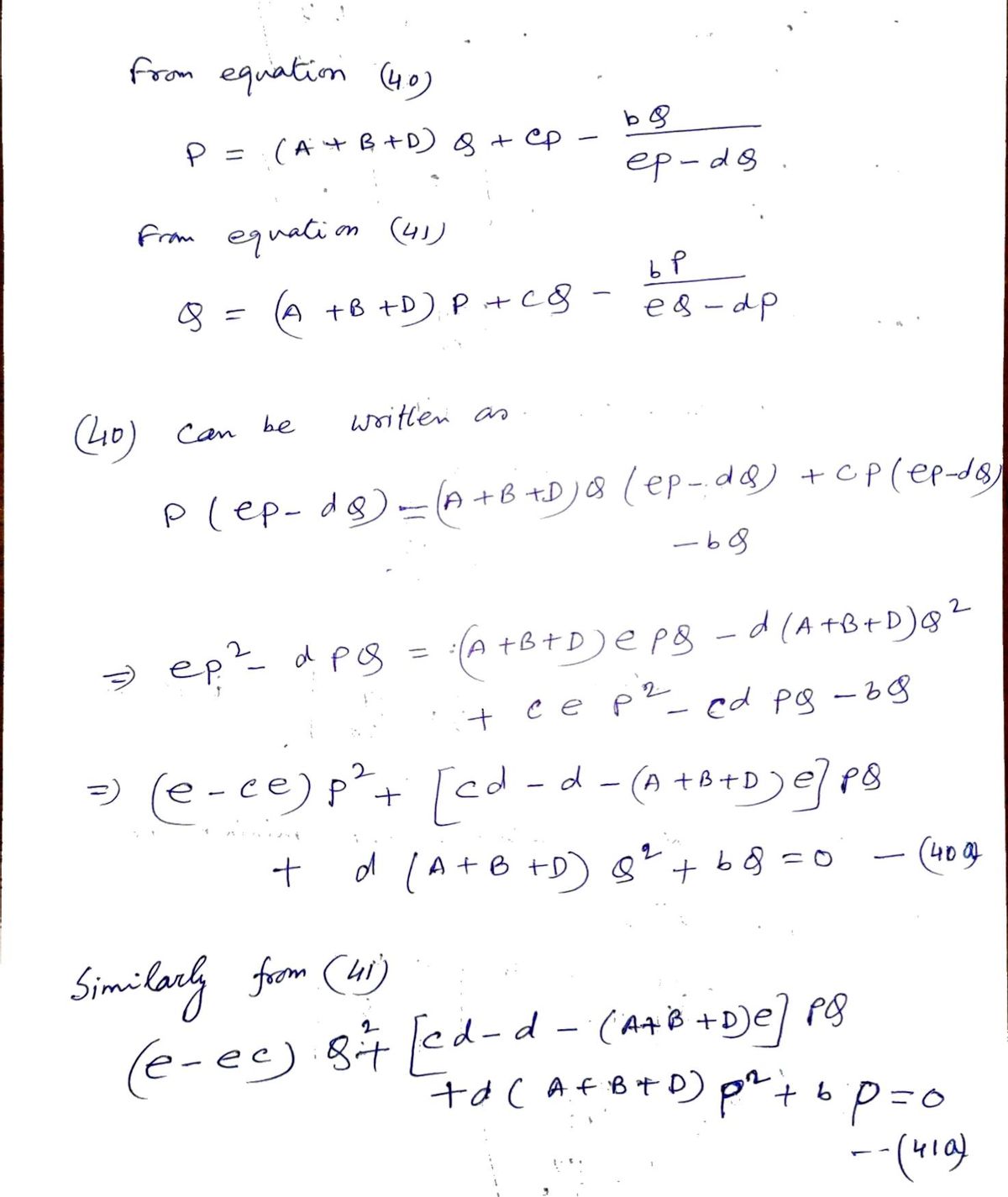Consequently, we get b P+Q= (42) [e (1 – C)– d (A+B+D)]’ where e (1– C)-d (A+B+D) > 0, eb² (1–C) PQ= (e+d) [(1– C)+ K4] [e (1– C)- d K4] (43)
Consequently, we get b P+Q= (42) [e (1 – C)– d (A+B+D)]’ where e (1– C)-d (A+B+D) > 0, eb² (1–C) PQ= (e+d) [(1– C)+ K4] [e (1– C)- d K4] (43)
Advanced Engineering Mathematics
10th Edition
ISBN:9780470458365
Author:Erwin Kreyszig
Publisher:Erwin Kreyszig
Chapter2: Second-order Linear Odes
Section: Chapter Questions
Problem 1RQ
Related questions
Topic Video
Question
Show me the steps of determine yellow and the inf is here
![Thus, we deduce that
(P+ Q)² > 4PQ.
(28)
difference equation
bxn-k
Xn+1 = Axn+ Bxn-k+Cxr-1+Dxn-o+
[dxn-k- exp-1]
(1)
n = 0, 1,2, ...
where the coefficients A, B, C, D, b, d, e E (0,), while
k,1 and o are positive integers. The initial conditions
X-o,..., X_1,..., X_k, ….., X_1, Xo are arbitrary positive real
numbers such that k<1< 0. Note that the special cases
of Eq.(1) have been studied in [1] when B=C= D=0,
and k= 0,1= 1, b is replaced by
B=C=D=0, and k= 0, b is replaced by – b and in
[33] when B = C = D = 0, 1 = 0 and in [32] when
A= C= D=0, 1=0, b is replaced by – b.
••.)
– b and in [27] when
6.](/v2/_next/image?url=https%3A%2F%2Fcontent.bartleby.com%2Fqna-images%2Fquestion%2F7ecaae78-467a-4f8b-9627-a81f9986c070%2F0acafe63-2942-4803-a517-03a969cf130b%2F52f6esb_processed.png&w=3840&q=75)
Transcribed Image Text:Thus, we deduce that
(P+ Q)² > 4PQ.
(28)
difference equation
bxn-k
Xn+1 = Axn+ Bxn-k+Cxr-1+Dxn-o+
[dxn-k- exp-1]
(1)
n = 0, 1,2, ...
where the coefficients A, B, C, D, b, d, e E (0,), while
k,1 and o are positive integers. The initial conditions
X-o,..., X_1,..., X_k, ….., X_1, Xo are arbitrary positive real
numbers such that k<1< 0. Note that the special cases
of Eq.(1) have been studied in [1] when B=C= D=0,
and k= 0,1= 1, b is replaced by
B=C=D=0, and k= 0, b is replaced by – b and in
[33] when B = C = D = 0, 1 = 0 and in [32] when
A= C= D=0, 1=0, b is replaced by – b.
••.)
– b and in [27] when
6.
![Theorem 12.If k, o are even and 1 is odd positive integers,
then Eq. (1) has prime period two solution if the condition
(Зе— d) (1— с) < (е+d) (А+B+ D),
(39)
is valid, provided C< 1 and e (1-C)-d(A+B+D) >
0.
Proof.If k, o are even and 1 is odd positive integers, then
Xn = Xn-k = Xn-o and xp+1 = Xp–1. It follows from Eq.(1)
that
bQ
P= (A+B+D) Q+CP –
(40)
(е Р- dQ)
and
bP
Q= (A+B+ D)P+CQ –
(41)
(e Q- dP)
Consequently, we get
P+Q=
(42)
[e (1- C)-d (A+B+D)]’
where e (1– C)-d (A+B+ D) > 0,
eb² (1-C)
PQ=
(43)
(e+d) [(1– C) + K4] [e (1 – C)– d K4]²
where K4 = (A+B+D), provided C< 1. Substituting
(42) and (43) into (28), we get the condition (39). Thus,
the proof is now completed.O](/v2/_next/image?url=https%3A%2F%2Fcontent.bartleby.com%2Fqna-images%2Fquestion%2F7ecaae78-467a-4f8b-9627-a81f9986c070%2F0acafe63-2942-4803-a517-03a969cf130b%2Fjr5laxm_processed.jpeg&w=3840&q=75)
Transcribed Image Text:Theorem 12.If k, o are even and 1 is odd positive integers,
then Eq. (1) has prime period two solution if the condition
(Зе— d) (1— с) < (е+d) (А+B+ D),
(39)
is valid, provided C< 1 and e (1-C)-d(A+B+D) >
0.
Proof.If k, o are even and 1 is odd positive integers, then
Xn = Xn-k = Xn-o and xp+1 = Xp–1. It follows from Eq.(1)
that
bQ
P= (A+B+D) Q+CP –
(40)
(е Р- dQ)
and
bP
Q= (A+B+ D)P+CQ –
(41)
(e Q- dP)
Consequently, we get
P+Q=
(42)
[e (1- C)-d (A+B+D)]’
where e (1– C)-d (A+B+ D) > 0,
eb² (1-C)
PQ=
(43)
(e+d) [(1– C) + K4] [e (1 – C)– d K4]²
where K4 = (A+B+D), provided C< 1. Substituting
(42) and (43) into (28), we get the condition (39). Thus,
the proof is now completed.O
Expert Solution
Step 1

Step by step
Solved in 3 steps with 3 images

Knowledge Booster
Learn more about
Need a deep-dive on the concept behind this application? Look no further. Learn more about this topic, advanced-math and related others by exploring similar questions and additional content below.Recommended textbooks for you

Advanced Engineering Mathematics
Advanced Math
ISBN:
9780470458365
Author:
Erwin Kreyszig
Publisher:
Wiley, John & Sons, Incorporated

Numerical Methods for Engineers
Advanced Math
ISBN:
9780073397924
Author:
Steven C. Chapra Dr., Raymond P. Canale
Publisher:
McGraw-Hill Education

Introductory Mathematics for Engineering Applicat…
Advanced Math
ISBN:
9781118141809
Author:
Nathan Klingbeil
Publisher:
WILEY

Advanced Engineering Mathematics
Advanced Math
ISBN:
9780470458365
Author:
Erwin Kreyszig
Publisher:
Wiley, John & Sons, Incorporated

Numerical Methods for Engineers
Advanced Math
ISBN:
9780073397924
Author:
Steven C. Chapra Dr., Raymond P. Canale
Publisher:
McGraw-Hill Education

Introductory Mathematics for Engineering Applicat…
Advanced Math
ISBN:
9781118141809
Author:
Nathan Klingbeil
Publisher:
WILEY

Mathematics For Machine Technology
Advanced Math
ISBN:
9781337798310
Author:
Peterson, John.
Publisher:
Cengage Learning,

